Cavalry in the American Civil War
The American Civil War saw cavalry tactics move largely away from the offensive towards the defensive, with the emphasis on screening, reconnaissance, raiding and harassment. Development of the rifled musket had also rendered the cavalry charge impractical.

In the first half of the war, the Confederates enjoyed the advantage in cavalry, as southern men were more accustomed to the riding and shooting life, and most of the experienced cavalry officers from the regular army had chosen to side with the Confederacy.
By the second half, from 1863 onward, the Union Army had gained an equal cavalry capability, through Benjamin Grierson's brilliant deception tactics in the Mississippi valley, and Philip Sheridan's aggressive movements, while in command of the Army of the Shenandoah at the end of the war in Virginia.
Cavalry units proved highly expensive to maintain, and unscrupulous agents would often exploit shortages by supplying defective animals at exorbitant prices.
Types of mounted forces
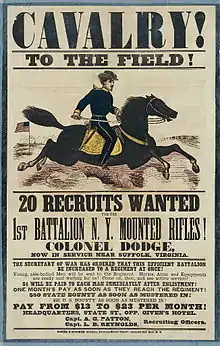
There were four types of mounted forces prevalent in the Civil War.
- Cavalry were forces that fought principally on horseback, armed with carbines, pistols, and sabers. Only a small percentage of Civil War forces met this definition—primarily Union mounted forces in the Eastern Theater during the first half of the war. Confederate forces in the East generally carried neither carbines nor sabers. A few Confederate regiments in the Western Theater carried shotguns, especially early in the war.
- Mounted infantry were forces that moved on horseback but dismounted for fighting on foot, armed principally with rifles. In the second half of the war, most of the units considered to be cavalry actually fought battles using the tactics of mounted infantry. An example of this was the celebrated "Lightning Brigade" of Col. John T. Wilder, which used horses to quickly arrive at a battlefield such as Chickamauga, but they deployed and fought using standard infantry formations and tactics. By contrast, at the Battle of Gettysburg, Federal cavalry under John Buford also dismounted to fight Confederate infantry, but they used conventional cavalry tactics, arms, and formations.
- Dragoons were hybrid forces that were armed as cavalrymen but were expected to fight on foot as well. The term comes from the French Army, representing a cross between light cavalry and infantry. The fighting tactics of the forces deployed by Union General Philip Sheridan in 1864, and by Confederate General Wade Hampton after the Battle of Yellow Tavern, fit the dragoon model, although those units did not adopt the term.
- Irregular forces (partisan rangers or guerrillas) were generally mounted forces. There is little commonality as to their weapons—in general, any available were used. The Confederacy produced the most famous irregular leaders, including William Clarke Quantrill and John S. Mosby.
Roles
At the time of the Civil War, the cavalry had five major missions, in rough priority:
- Reconnaissance and counter-reconnaissance screening
- Defensive, delaying actions
- Pursuit and harassment of defeated enemy forces
- Offensive actions
- Long-distance raiding against enemy lines of communications, supply depots, railroads, etc.
This represented a change from previous eras, in which offensive action was the primary mission. In the Napoleonic Wars, for instance, there were instances of massive cavalry charges used for tactical envelopments of infantry formations. The technology of the rifled musket, which emerged in the 1850s, put an effective end to this practice. While swiftly moving cavalry could overwhelm infantry whose weapons fired accurately only 100 yards, the infantryman with a rifled musket (accurate to 300 yards or more) could fire multiple rounds in the time it took the cavalry to reach his position. A horse and rider were easy targets for these shots.
Offensive actions were certainly not unknown, however, but they were more frequently employed against enemy cavalry than against infantry. Examples of offensive actions include the Battle of Brandy Station and the Battle of Yellow Tavern; cavalry versus cavalry examples include the First Battle of Bull Run and Elon J. Farnsworth's ill-fated charge on the third day of the Battle of Gettysburg.
Reconnaissance was the key to effective cavalry, as it remains today in modern armies (although modern cavalrymen use light armored vehicles or helicopters instead of horses). The cavalry serves as the "eyes" of the army. Reconnaissance was a crucial component in the Gettysburg Campaign, where cavalry under Union General Alfred Pleasonton attempted to find the wide-ranging Army of Northern Virginia on its invasion of the North, and Confederate cavalry under J.E.B. Stuart effectively employed counter-reconnaissance to screen passes in the Blue Ridge Mountains and hide Robert E. Lee's movements.
Long-distance raids were the most desirable mission for cavalrymen, primarily because of the fame that successful raids would bring, but they were often of little practical strategic value. Jeb Stuart became famous for two audacious raids on the Union Army of the Potomac in 1862; in his third such attempt, during the Gettysburg Campaign, he squandered much of the cavalry forces of the Army of Northern Virginia and deprived Robert E. Lee of adequate reconnaissance at the beginning of the Battle of Gettysburg, one of the principal reasons for the Confederate defeat there. Union attempts at strategic raids had mixed success. George Stoneman's raid in the Battle of Chancellorsville was a failure; Benjamin Grierson's raid in the Vicksburg Campaign was a strategic masterpiece that diverted critical Confederate forces away from Ulysses S. Grant's army; James H. Wilson's massive 1865 raid in Alabama foreshadowed the armored warfare maneuvers of World War II. In general, strategic raids were used more effectively in the Western Theater of the war.
Defensive actions by the cavalry were critical in the retreat from Gettysburg. Pursuit and harassment of enemy forces were often neglected (particularly by the Union after Gettysburg and Antietam), but can be seen in their finest form in the pursuit of Robert E. Lee during the Appomattox Campaign.
Organization
.jpg.webp)
Until the nomenclature changed in the early 1880s, cavalry regiments were organized into companies (later, "troops") authorized at up to 100 men, ten companies made up a regiment (increased to twelve post-war). Two or more companies might be organized into ad hoc battalions (later, "squadrons"), two "wings" of six companies each was used through the Indian Wars. Civil War regiments were rarely near authorized strength so that they were commonly brigaded with two to four other regiments. Two to four brigades were combined into divisions. By the end of the war, 272 cavalry regiments were formed in the Union Army and 137 in the Confederate Army.
Early in the war, most cavalry regiments were dispersed to be under the command of infantry formations, such as divisions or corps. As commanders realized the importance of long-range reconnaissance and raiding, the organizations changed to consolidate more of the regiments into larger units controlled separately. Eventually the Union Army of the Potomac included a Cavalry Corps, which had three divisions. The Army of Northern Virginia, earlier to consolidate under J.E.B. Stuart, organized its force as a cavalry division.
In both armies, the cavalry was accompanied by batteries or battalions of horse artillery, as well as its own train of ammunition and supply wagons.
Equipment
Horses
The principal item of equipment for a cavalryman was the horse and one of the reasons both North and South initially hesitated in forming mounted units was because of financial considerations; each cavalry regiment cost $300,000 for initial organization with annual upkeep expenses tallying over $100,000. Both cavalries originally required recruits or local communities to provide horses, a policy that lasted briefly in the North, while the South maintained it throughout the war even though Richmond leaders recognized its serious drawbacks. While Confederate troopers bore the monetary cost of keeping themselves mounted, Union cavalrymen rode quartermaster-issued animals obtained through public contracts (although officers had to reimburse the cost of their mounts to the government). While open to fraud early in the war, once tightened regulations and stringent inspections were enforced, the contract system yielded an estimated 650,000 horses for Union armies during the war exclusive of an additional 75,000 confiscated in Confederate territory.[1]
Union army guidelines for cavalry horse selection mandated animals be at least 15 hands high, weighing minimally 950 pounds and aged between 4 and 10 years old, and be well-broken to bridle and saddle. Animals were to be dark colors and free from defects such as shallow breathing, deformed hooves, spavin or ringbone. Geldings were preferred for cavalry horses with the purchase of mares strictly prohibited outside absolute military emergency and stallions' volatility and aggressiveness made them generally unsuitable for service. In the Confederacy, limited horse numbers did not permit such selectivity in trying to keep their armies horsed.[2]
Cavalry horse prices varied throughout the war; in 1861 the maximum government price for cavalry horses was $119. However, relentless military demand caused prices to continually increase and by 1865 prices hovered near $190 per head. In the Confederacy horse prices rapidly spiraled upward due to animal scarcity and inflation costing over $3,000 by war's end.[3] The daily feed ration for Union cavalry horses was ten pounds of hay and fourteen pounds of grain which were ample and fulfilled the animals' nutritional needs if of good quality, however, the vagaries of the army supply system did not always insure prescribed forage amounts were delivered where most needed.[4]
On both sides volunteer officers often proved notably lax in promoting strict animal welfare, a shortcoming exacerbated by the absence of a trained and organized veterinary corps which allowed serious maladies like strangles, grease heel, farcy, and glanders to spread among army stock. The U.S. Congress finally created the rank of veterinary sergeant in March 1863, but the meager pay and rank held no inducement for qualified candidates to join the army. Repeated calls to establish a professional military veterinary service failed, and widespread waste, suffering, and destruction among army horses resulted; not until 1916 was an official U.S. army veterinary corps founded.[5]
Horses gave the cavalry forces significant mobility. In some operations, forces were pushed to the limit (such as Jeb Stuart's raid on Chambersburg, Pennsylvania, in 1862, where his troopers marched 80 miles (130 km) in 27 hours). Such excesses were extremely damaging to the readiness of the units and extensive recovery periods were required. Stuart, during the Gettysburg Campaign the following year, resorted to procuring replacement horses from local farmers and townspeople during his grueling trek northward around the Union army. In York County, Pennsylvania, following the Battle of Hanover, his men appropriated well over 1,000 horses from the region. Many of these untrained new mounts proved a hindrance during the subsequent fighting at East Cavalry Field during the battle of Gettysburg.
Weaponry

Some mounted forces used traditional infantry rifles. However, cavalrymen, particularly in the North, were frequently armed with three other weapons:
- Carbines, with a shorter barrel than a rifle, were less accurate, but easier to handle on horseback. Most carbines were .52- or .56-caliber, single-shot breech-loading weapons. They were manufactured by several different companies, but the most common were the Sharps, the Burnside, and the Smith. Late in 1863, the seven-shot Spencer repeating carbine was introduced, but it was rarely deployed. A notable exception was Union Colonel John T. Wilder, who equipped an entire brigade with repeaters (purchasing these himself and intending to deduct payment from the men's wages embarrassed the Government into paying Wilder for the weapons at $35 apiece) in May 1863, the first unit so equipped. His mounted infantry gained fame as the "Lightning Brigade" for their swift movements. One Confederate stated that Wilder's men could "load on Sunday and fire all week." (Confederate forces were able to use captured breechloaders but were unable to duplicate the metallic cartridges needed by the Spencer.)
- Pistols, which Southern cavalrymen generally preferred over sabers, were usually six-shot revolvers, in .36- or .44-caliber, from Colt or Remington. They were useful only in close fighting since they had little accuracy. It was common for cavalrymen to carry two revolvers, for extra firepower, and John Mosby's troopers often carried four each.
- Sabers were used frequently by cavalrymen on both sides. They were terror weapons, more useful for instilling fear in their opponents than as practical offensive weapons; Confederate cavalrymen often avoided them simply because they considered sabers to be outmoded, unsuitable for the modern battlefield. One Southern cavalry commander noted that the only times during the war he used a saber was to roast meat over a fire. Despite some Southern attitudes towards such weapons, there were several notable instances where the saber saw much use by both sides, including the Battle of Brandy Station and the cavalry battles on the third day of Gettysburg. Notably, South Carolina cavalry regiments as well as the cavalry commanded by General Wade Hampton had an intense fondness for the saber. One officer in the 2nd South Carolina cavalry regiment was quoted saying, "There was nothing Hampton's men liked so well in a fight as a chance to use their sabers." The American Pattern of 1860 Light Cavalry Saber was lighter than the typical European saber, the latter being similar to the older U.S. Model 1840 Heavy Dragoon "wrist breaker".
Confederate cavalry
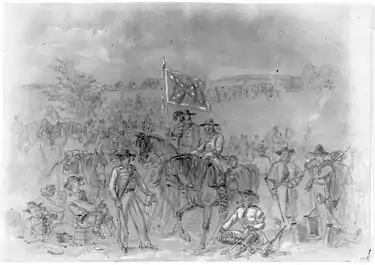

A Southerner was, on average, considered a superior horseman to his Northern counterpart, especially early in the war. Roads in the rural South were generally poor, and horses were used more for individual transportation than they were for the carriages and streetcars of the urbanized North, where many of the early Federal cavalry regiments were formed.[6] Furthermore, Southern society was more stratified, which made the soldiers more accustomed to a hierarchy of command and were generally considered more suited to the martial lifestyle. Additionally, the strong militia tradition in the antebellum South and the requirements for local 'slave catcher' patrols led to the development of mounted units prior to 1861.
Confederate soldiers owned their horses and were compensated on a monthly basis. If a soldier's horse was sick, injured, or killed, the soldier was responsible for returning home and replacing the horse at his own expense. The general rule was that the soldier had 60 days to return with a new horse or he was forced to become an infantryman, which was considered to be an ignominious fate.
The first prominent Confederate cavalry leader was J.E.B. Stuart, who achieved success in the First Battle of Bull Run against infantry. He was a flamboyant dresser and an audacious commander, wildly popular with the Southern public for his escapades in twice encircling the Army of the Potomac. These long-range reconnaissance missions accomplished little of military value but boosted Southern morale. After Stuart's death in 1864, he was replaced by Wade Hampton, who was a more mature, and arguably more effective, commander. Another Eastern commander of note was Turner Ashby, the "Black Knight of the Confederacy", who commanded Stonewall Jackson's cavalry forces in the Valley Campaign; he was killed in battle in 1862.
In the Western Theater, the most fearless, and ruthless, cavalry commander was Nathan Bedford Forrest, who achieved spectacular results with small forces but was an ineffective subordinate to the army commanders he was supposed to support, resulting in poorly coordinated battles. Much of the same issues could be said of Forrest's counterpart in the Army of Tennessee, John Hunt Morgan. In the Eastern Theater, the Partisan Ranger John Singleton Mosby succeeded in tying down upwards of 40,000 Federal troops defending rail lines and logistical hubs with only 100-150 irregulars. In the Trans-Mississippi Theater, John S. Marmaduke and "Jo" Shelby became prominent.
Union cavalry
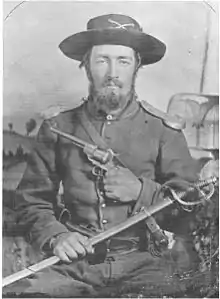
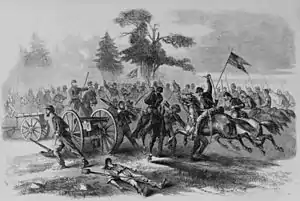
The Union started the war with five Regular mounted regiments: the 1st and 2nd U.S. Dragoons, the 1st Mounted Rifles, and the 1st and 2nd Cavalry. These were renumbered the 1st through 5th U.S. Cavalry regiments, respectively, and a 6th was recruited. The Union was initially reluctant to enlist additional regiments, because of the expense, the understanding that training an effective cavalryman could take as long as two years, and the conventional wisdom that the rough and forested terrain of the United States, being so different from that of Western Europe, would make the deployment of Napoleonic-style cavalry forces ineffective. As the war progressed, the value of cavalry was eventually realized (primarily for non-offensive missions), and numerous state volunteer cavalry regiments were added to the army. While initially reluctant to form a large cavalry force, the Union eventually fielded some 258 mounted regiments and 170 unattached companies, of differing enlistment periods, throughout the war and suffered 10,596 killed and 26,490 wounded during the struggle.[7]
The Union cavalry was disadvantaged at the start of the war because Northern soldiers allegedly had less comparative equestrian experience than their Southern counterparts, and the Union army did not institute an examination in basic horsemanship before a recruit was mustered into service until August 1862.[8] In addition, over half (104 out of 176) of the experienced U.S. Army cavalry officers had resigned their commissions to fight for the Confederacy. One advantage the Union horseman had over his opponent was the centralized horse procurement organization of the army, relieving him of any responsibility for replacing an injured horse. Commanders often tried to procure specific breeds for their men, with the Morgan being a particular favorite within the Army of the Potomac. Famous Morgan cavalry mounts from the Civil War included Sheridan's "Rienzi"[9] and Stonewall Jackson's "Little Sorrel".
Early in the war, Union cavalry forces were often wasted by being used merely as pickets, outposts, orderlies, guards for senior officers, and messengers. The first officer to make effective use of the Union cavalry was Major General Joseph Hooker, who in 1863 consolidated the cavalry forces of his Army of the Potomac under a single commander, George Stoneman.
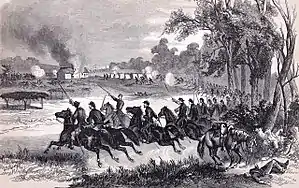
Halfway into the war, during the summer of 1863, the Union cavalry came into its own. Widely regarded as inferior to its Southern counterpart up until then, the Battle of Brandy Station, although tactically indecisive, is recognized as the point at which it was acknowledged to have comparable competence.
In 1864, Philip Sheridan was given command of the Cavalry Corps of the Army of the Potomac, and he deployed his horsemen in a more effective, strategic way than his predecessors. Despite the reluctance of his superior, Major General George G. Meade, Sheridan convinced General-in-Chief Ulysses S. Grant to allow him to deploy the cavalry in long-range raids, the first of which, at Yellow Tavern, resulted in the death of Confederate commander Jeb Stuart. He later employed his cavalry force effectively in the Valley Campaigns of 1864 and the Appomattox Campaign, in pursuit of Robert E. Lee.
In the Western Theater, two effective cavalry generals have not achieved the fame of their Eastern counterparts: Benjamin Grierson's dramatic raid through Mississippi was an integral part of Ulysses S. Grant's Vicksburg Campaign; James H. Wilson was invaluable in the Franklin-Nashville Campaign and in his 1865 Alabama raid.
Significant cavalry battles and raids
The following are Civil War battles, campaigns, or separate raids in which cavalry forces played a significant role.
- Battle of Brandy Station — 20,500 combatants, in 1863, Pleasanton leads the largest predominantly cavalry battle of the war
- Battle of Chancellorsville — ambitious plan for raid in the Confederate rear foiled by George Stoneman's inaction
- Battle of Gaines's Mill — the first large cavalry engagement of the war
- Battle of Gettysburg, Third Day cavalry battles — East Cavalry Field and Farnsworth's Charge
- Battle of Franklin — James H. Wilson's repulse of Forrest probably saved the Union army
- Battle of Mine Creek — 9,600 cavalry, in 1864, Pleasanton leads the largest cavalry battle west of the Mississippi
- Battle of Sailor's Creek — masterful cavalry maneuvers brought Confederates close to surrender in the Appomattox Campaign.
- Battle of Selma — James H. Wilson's massive raid into Alabama in 1865
- Battle of Trevilian Station — 16,048 cavalry, in 1864, Sheridan leads largest all-cavalry battle of the war
- Battle of Yellow Tavern — J.E.B. Stuart killed in action by Philip Sheridan's cavalry
- Dahlgren's Raid — unsuccessful Union raid against Richmond
- Gettysburg Campaign — numerous cavalry actions in Robert E. Lee's invasion of Pennsylvania
- Grierson's Raid — long-range raid through Mississippi in conjunction with Ulysses S. Grant's Vicksburg Campaign
- Maryland Campaign — J.E.B. Stuart's second ride around the Union army
- Peninsula Campaign — Stuart's first ride around the Union army
- Price's Raid — Sterling Price's 1864 raid in the Trans-Mississippi Theater
- Streight's Raid — 1863 raid across Alabama in which Col. Abel Streight surrendered 1,500 men to Forrest's 400
- Third Battle of Winchester — 9,300 cavalry, Sheridan battled Early in 1864, in the Shenandoah valley
- Wilson's Raid — James H. Wilson's 1865 raid through Alabama and Georgia
- Morgan's Raid — John H. Morgan's raid through Kentucky, Indiana and Ohio.
Notable cavalry leaders and partisan rangers
Notes
- National Archives, RG 92, James A. Ekin to Montgomery Meigs, January 31, 1866
- National Archives, RG 92, Quartermaster Department Circular, "Instructions for Inspectors of Cavalry Horses," February 5, 1864; Gerleman, David J. "Warhorse! Union Cavalry Mounts." North and South Magazine (January 1999)
- Reports of Committees of the House of Representatives, 37th Cong., 2d sess., 1861-62, part I, 84; O.R.III, vol. 5, 256
- O.R. Series I, vol. XXIX, pt. 2, 423
- "Our Cavalry," The United States Army and Navy Journal, I (February 1864); Gerleman, David J. "A Blot on the Army: Veterinary Care in the Union Cavalry, 1861–1865," Smithsonian Institution Civil War Sesquicentennial Symposium, November 2012
- Hamner, Christopher. "Union Cavalry." Teachinghistory.org. Accessed 11 July 2011.
- "Cavalry, U.S.A." in Encyclopedia of the American Civil War, David S. Heidler and Jeanne T. Heidler, eds., Vol. 1, A-C, (ABC-CLIO Publishers, 2000), pp. 378-381
- O.R. Series III, vol II, 381
- Pedigree of Reinz, a famous Morgan horse used by General Philip H. Sheridan.
References
- Introduction to Civil War Cavalry
- Longacre, Edward G. Lincoln's Cavalrymen: A History of the Mounted Forces of the Army of the Potomac. Mechanicsburg, PA: Stackpole Books, 2000. ISBN 0-8117-1049-1.
- Longacre, Edward G., and Eric J. Wittenberg. Unpublished remarks to the Civil War Institute, Gettysburg College, June 2005.
- Mackey, Robert R. The UnCivil War: Irregular Warfare in the Upper South, 1861-1865. Norman: University of Oklahoma Press, 2004. ISBN 0-8061-3624-3.
- Nosworthy, Brent. The Bloody Crucible of Courage, Fighting Methods and Combat Experience of the Civil War. New York: Carroll and Graf Publishers, 2003. ISBN 0-7867-1147-7.
Further reading
- Gerleman, David J. "Warhorse! Union Cavalry Mounts." North and South Magazine Vol. 2, No. 2, (January 1999), pp. 47–61.
- Longacre, Edward G. The Cavalry at Gettysburg. Lincoln: University of Nebraska Press, 1986. ISBN 0-8032-7941-8.
- Longacre, Edward G. General John Buford: A Military Biography. Conshohocken, PA: Combined Publishing, 1995. ISBN 0-938289-46-2.
- Longacre, Edward G. Lee's Cavalrymen: A History of the Mounted Forces of the Army of Northern Virginia. Mechanicsburg, PA: Stackpole Books, 2002. ISBN 0-8117-0898-5.
- Starr, Stephen Z. The Union Cavalry in the Civil War. Vol. 1, From Fort Sumter to Gettysburg 1861–1863. Baton Rouge: Louisiana State University Press, 1981. ISBN 978-0-8071-3291-3.
- Starr, Stephen Z. The Union Cavalry in the Civil War. Vol. 2, The War in the East from Gettysburg to Appomattox 1863–1865. Baton Rouge: Louisiana State University Press, 1981. ISBN 978-0-8071-3292-0.
- Starr, Stephen Z. The Union Cavalry in the Civil War. Vol. 3, The War in the West 1861–1865. Baton Rouge: Louisiana State University Press, 1981. ISBN 978-0-8071-3293-7.
- Wills, Brian Steel. The Confederacy's Greatest Cavalryman: Nathan Bedford Forrest. Lawrence: University Press of Kansas, 1992. ISBN 0-7006-0885-0.
- Wittenberg, Eric J. Glory Enough For All: Sheridan's Second Raid and the Battle of Trevilian Station. Washington, DC: Brassey's, Inc., 2001. ISBN 1-57488-468-9.
- Wittenberg, Eric J. The Battle of Brandy Station: North America's Largest Cavalry Battle. Charleston, SC: The History Press, 2010. ISBN 978-1-59629-782-1.